A weird, lovely, fantastic object out of nature like Delicate Arch has the curious ability to remind us - like rock and sunlight and wind and wilderness - that out there is a different world, older and greater and deeper by far than ours, a world which surrounds and sustains the little world of men as sea and sky surround and sustain a ship. The shock of the real. For a little while we are again able to see, as a child sees, a world of marvels. For a few moments we discover that nothing can be taken for granted, for if this ring of stone is marvelous then all which shaped it is marvelous, and our journey here on earth, able to see and touch and hear in the midst of tangible and mysterious things-in-themselves, is the most strange and daring of all adventures.
-- Edward Abbey, Desert Solitaire
In 1957, Edward Abbey took a job as a seasonal ranger at Arches National Monument. He was assigned as the on-site ranger, staying in a prefab home in what is now the middle of the park. Access to the park was via an unpaved road, and total visitation for the year was 28,000 people. Today, Arches National Park - now easily accessible via a paved road - receives more than a million visitors per year, and the nearby town of Moab has become a world class destination for desert adventure seekers.
Within its 73,000 acres is the densest collection of natural arches on the Earth - more than 2,000 by the Park Service's count! But, as Abbey so astutely notes in his account, the arches themselves are but a minor part of the park - it's the desert as a whole that makes Arches special.

Arches Panorama, near the Courthouse Towers |
Unlike some of the larger parks, Arches doesn't really have "sections"; for visitation purposes, it is pretty much a linear park. When planning to visit Arches, then, it's more important to know how long you'll be there, when you'll be there, and what's available than it is to figure out where in the park you want to go...
Just From The Pavement
More than 90 percent of all visitors to Arches keep their cars on the main 22-mile road and its two short spurs, and for good reason - most of the famous features within the park can be seen with less than a one mile walk on easy trails. In fact, many can be seen (if less than ideally) from the road itself.
The entrance to the park is about two miles north of Moab, where a new visitor center provides educational opportunities about the sandstone formations that make Arches what it is. Beyond the visitor center, the park road winds up the side of the canyon formed by the Moab Fault, past the Penguins and along the Great Wall until the full splendor of the park comes in to view at the top. Like most caves - and much of canyon country - Arches is populated by formations with interesting and colorful names.
From the road's many parking lots you can look down into the wide fin canyon of Park Avenue, stand beneath the Courthouse Towers, gaze at Balanced Rock (and, if you want, walk across the street and stand where Abbey's trailer home used to sit), or view a number of the park's arches and hoodoos (standing eroded rock formations of varying generally columnar shapes). Of course, if you want to get the best views of the features you have to...

Mists of [the Garden of] Eden |
Get Out And Walk
Yes, you can see most of the park's main features from right near the road, though only a few are best seen from the parking lots. And besides, making Arches an auto tour doesn't really let you experience the wonder of the slickrock desert. To really see and experience Arches, you need to get out of the car and walk.
You don't have to walk far; as I note above, most of the park's sights are within a mile's easy hike from a parking lot. The walk to stand under Double Arch is a short but sandy one, and the trip up to the Windows is about a quarter mile with some broad steps along the way. Landscape Arch, the second longest freestanding arch in the world at just under a football field in length, is an easy and fun one mile (each way) hike.
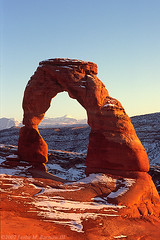 Delicate Arch also has viewpoints available just a short walk from the car, but to get up close to it to really appreciate its beauty requires a bit more - and in my opinion by giving a bit more of your time and energy to the park is when it transforms from interesting into magical. The 1.6 mile (one-way) hike up over open slickrock - and one reasonably wide ledge - takes you to the top of the desert with expansive views, rock "haystacks", and of course the completely freestanding 52 foot tall Delicate Arch itself. Park Avenue is another short but somewhat steep hike that really transforms its location; a walk among the walls of rock past twisted juniper and water-worn sandstone is an immersive experience.
Delicate Arch also has viewpoints available just a short walk from the car, but to get up close to it to really appreciate its beauty requires a bit more - and in my opinion by giving a bit more of your time and energy to the park is when it transforms from interesting into magical. The 1.6 mile (one-way) hike up over open slickrock - and one reasonably wide ledge - takes you to the top of the desert with expansive views, rock "haystacks", and of course the completely freestanding 52 foot tall Delicate Arch itself. Park Avenue is another short but somewhat steep hike that really transforms its location; a walk among the walls of rock past twisted juniper and water-worn sandstone is an immersive experience.
If you want a longer hike, I highly recommend some or all of the 7.2 mile loop-plus-spurs Devil's Garden trail. Along the way you'll pass the trail's star attraction of Landscape Arch on your way to a number of other arches and at last to the lone figure of Dark Angel. On the way back, take the primitive trail for a more adventuresome experience.
One other hike deserves special mention. If you're in the park between April and October and you want a fun experience (as well as some relief from the summer sun), sign up for a hike in to Fiery Furnace. This is a guided tour into an unmarked and very confusing maze of fin canyons. Along the way you'll see some arches, learn whatever it is the guide decides to teach, and get a chance to do some easy canyoneering techniques. The hike includes some short sections which might set off a fear of heights or enclosed places - more the latter than the former - so if you're particularly sensitive to those things, it might not be for you.
All of these hikes are very popular, though the crowd thins considerably on the second half of the Devil's Garden hike. If you want to get away from people in the park you have to go...
Off The Main Drag
While the main part of the park lies along the road, there are a few places you can go that are much less well traveled. Some of them require a four wheel drive vehicle or a long hike; if you want to reach these more remote places, be sure you know what the conditions are on the roads, and any hazards along the trails at the time of your trip - see the rangers in the visitor center for the most up-to-date conditions.
The first "remote" destination is actually not remote at all - you can start on the main road just past the Courthouse Towers. The Courthouse Wash is canyon cut in its upper section from the Entrada Sandstone that forms many of the park's formations, and in the lower section through Navajo Sandstone dunes. Depending on your time and level of adventure you can choose to hike some or all of the 12 miles (each way, or arrange a shuttle) starting at US-191 and Sevenmile Wash, through the park and down to the exit of Courthouse Wash just outside of Moab.
Another remote location, usually accessible via passenger car on a graveled road, is the Klondike Bluffs. There were only about five parking spots at the main Bluffs lot when I was last out there, so crowds are guaranteed to be minimal - though parking is obviously at a premium. From there a trail leads up and into the bluffs area, ending up at Tower Arch - a 1.7 mile trip each way. Those in high clearance 4WD vehicles can start much closer to Tower Arch, but what's the fun in that?
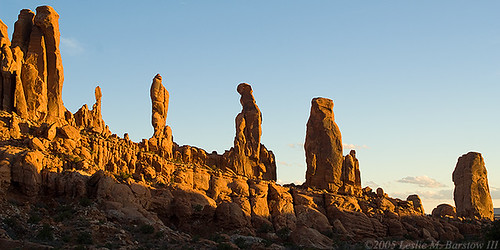
The Marching Men, Klondike Bluffs |
Two other remote areas are worth at least a mention - the Herdina Park and Lost Spring areas. Herdina Park is near the original park entrance, now accessible only by a 4WD road; fewer people probably travel there now than during Abbey's days as a ranger. It boasts a neat looking arch - the Eye Of The Whale - and is a reasonably short 2.5 mile one-way hike from the point where Willow Flats Road becomes inaccessible to passenger cars. The Lost Spring section of the park is a more recent addition and is entirely undeveloped. Adventurous sorts can access it either by a long hike from the Sand Dune Arch parking lot, or via an external 4WD road. No formal trails exist into this area; see the park website for more details, and do some extra research - I've never been out there, so I can only mention it.
More Than Just The Park
Moab, where you'll likely be staying if you can't get a camping spot inside the park, is a hub for all sorts of desert activities and is a good place to base your broader exploration of some of Utah's best scenery. Here's a by-no-means-exhaustive list of other things you can do while you're in the area.
- Visit Canyonlands National Park's Island In The Sky district and Dead Horse Point. These two destinations go together, and they offer similar views of the multi-layered canyons that make up the northeast section of Canyonlands. I personally think Canyonlands is nicer than the Grand Canyon in many respects; it's certainly a less-traveled alternative. You can certainly take some long hikes from this section of the park, but much of the scenery is convenient to auto tourists.
- Visit Canyonlands Needles district and Newspaper Rock. The Needles district offers access to a lower section of the canyons as well as many of the park's more interesting features. There are many very long hikes available in this area. Along the way, stop at Newspaper Rock - an almost overwhelming accumulation of ancient petroglyphs.
- Visit Fisher Towers and Castle Valley. These two often-filmed iconic areas are only a scenic trip along the Colorado River away from Moab. You might also want to take the La Sal Loop out of Castle Valley, which takes you up out of the desert and in to the pine and Aspen forests of the mountains.
- Take a boat. The Colorado and Green Rivers both have excellent boating opportunities through deep redrock canyons, ranging from whitewater rafting to tour boat trips to multi-day flatwater canoe trips.
- Take a jeep trip. Moab is probably the world capital of four wheel drive adventure. 4WD trips range from tame (the 4WD roads within Arches) to extreme (the Behind-The-Rocks vehicle eater). In between there are many world class routes, including the multi-day White Rim Trail (accessible via Canyonlands Island in the Sky), the challenging Flint Trail in the Canyonlands Maze district, and the pounding route of Elephant Hill in the Needles district.
- Take a bike ride. Moab is also a Mecca for off-road bicyclers looking for slickrock challenges. In addition to short "day" challenges, you can also take a long trip on your bike. The White Rim Trail is popular as a multi-day bike tour, usually with an accompanying 4WD vehicle.
One More Thing...
Actually, a few, and mostly cautions.
Moab is a busy place. It hosts many festivals and a lot of visitors throughout the year. Tourist season may be from June through September, but the area is popular from March through October and at some times during the winter. Plan ahead.
Don't Bust The Crust. The Colorado Plateau is home to an abundance of an almost invisible yet vital organism - cryptobiotic crust. The crust grows very slowly, stabilizing the desert soils and providing an island in the shifting sands from which plants can grow. Stay on the marked trails, or when necessary step on rock or sandy wash beds.
Take lots of water with you when you head out. Then take some more - it's a desert, and the available water isn't usually good for you.
And finally, I would encourage you to relax and take it all in, from the intricate patterns of rock swirls or branching lichens to the grand landscape around you and the sky above, and maybe be reminded that out there is a different world, older and greater and deeper...
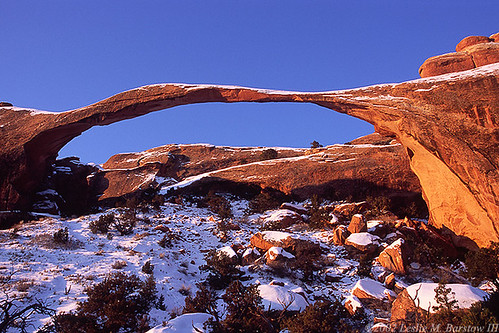
Landscape Arch |
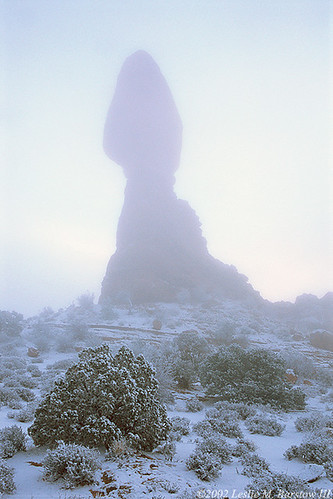
Balanced Rock |
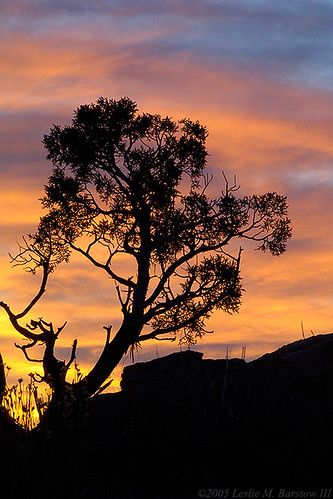
A Juniper at Sunset, Klondike Bluffs |
It is, of course, impossible to cover every aspect of Arches and the surrounding area in the course of a single diary. It's also hard for one person to have a broad enough perspective to cover everything. So now, in the tradition of these diaries, please add your own comments - or ask your own questions - on Arches.
This has been another installment in the Park Avenue "Things To Know Before You Go..." series. Previous diaries in this series have covered Yellowstone,Yosemite, Olympic, Glacier Bay, and Acadia. You can vote which park to cover next by visiting the Park Avenue Photo Friday & Open Thread diaries. Also be sure to catch the group's less travel-orented park series on Thursdays; this week Ed in Montana will be presenting a feature on Death Valley.
If you want to follow this group on a regular basis, click on the Park Avenue group link, then click the Follow link in the group box on the right-hand side of the page.
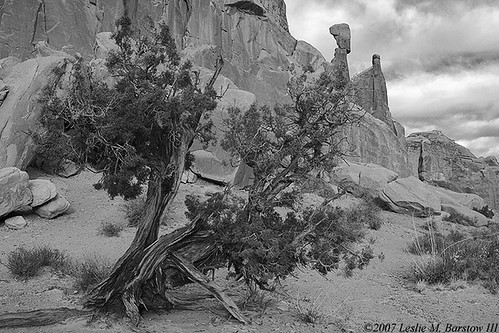
Park Avenue |


